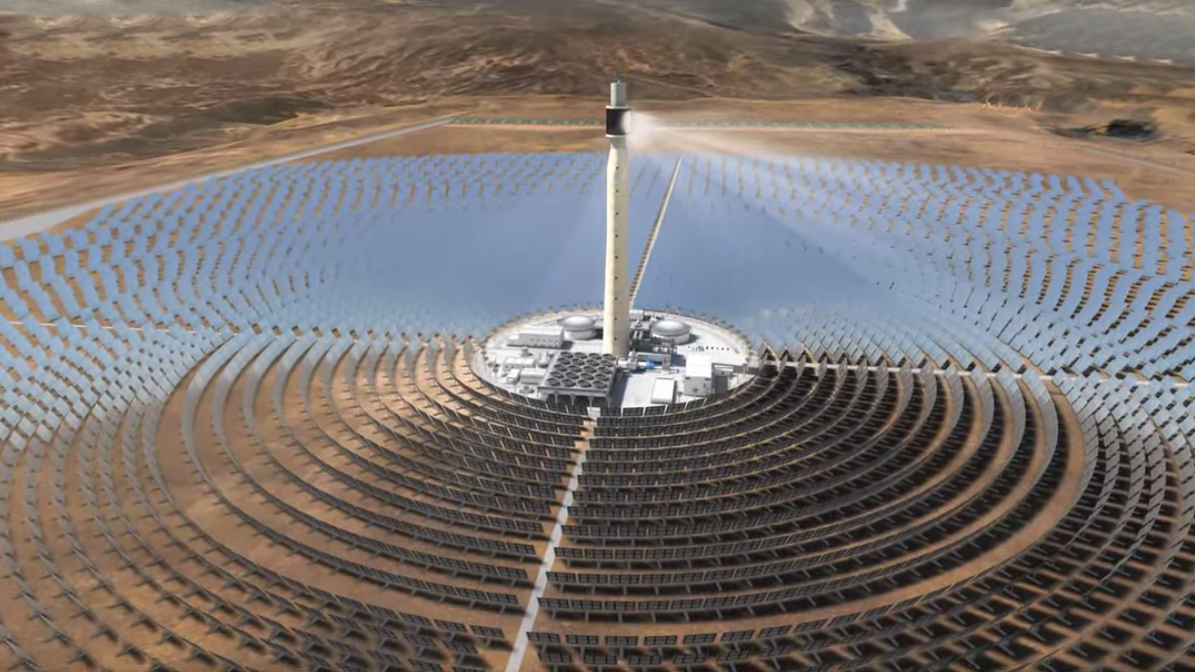Few people get excited about the construction of a new power line; the fact that I do probably tells you that I firmly belong into the world of tech nerds. But there is a reason why enthusiasm is not misplaced here. On April 30, 2019, the governments of Italy and Tunisia entered into an agreement to build a trans-Mediterranean submarine power line from Partanna, Sicily, to El Hauouaria in Tunisia. The ELMED (Italy-Tunisia) Interconnector, as it is formally known, will run 250 kilometers in total, with 192 kilometers below the Mediterranean Sea. The High-Voltage Direct Current (HVDC) line will has a capacity of 600 Megawatt (MW) and operate at 400 kiloVolt (kV). The project is estimated to cost about $900 million in Canadian currency (€600m), half of it to be financed by the European Union.

Morocco's Noor III solar power plant in Ouarzazate
By power line standards, a 600 MW line is not all that exceptional; our local BC-Washington state intertie carries up to 3,150 MW southwards and 2,000 WM northwards, for example. What makes the project exciting is the fact that it will help carry clean solar power from sun-rich North African countries to Europe. About a decade ago, a consortium called Desertec developed a bold vision for bringing solar power from Africa to Europe. The project was supported by some of the big names in the electricity sector. Economically, it was ahead of its time, however. The ELMED intertie is envisioned as a bidirectional business model: it can also help with Tunisia's power shortages. Together with links between Morocco and Spain, the Italy-Tunisia link can help close an important gap in the power links between the two regions.
Even though ELMED will help Tunisia foremost, it fits well into the developing supply of renewable energy in North Africa. The Ouarzazate project in Morocco stands out, pictured above. Phase III of the project involves a 140 MW solar-thermal installation, which complements two earlier phases that have been in operation since 2016. Noor I has 160 MW nameplate capacity, and Noor II an additional 200 MW. Phase IV is planned as an 72 MW photovoltaic system. Annual net output of all three phases is estimated as 1,470 Gigawatthours (GWh), about 5% of Morocco's total electricity demand. Morocco plans to install 2 GW of solar-based generation capacity by 2020, and another 2 GW of wind power for 6,600 GWh of output. According to a CNN report, Morocco is on track to generate 42% of its electricity from renewable sources by 2020. Regional plans are even larger, but are still far below the €400 billion vision of the Desertec initiative. Exporting solar power from Northern Africa is becoming a profitable business proposition, but the infrastructure to bring this power across the Mediterranean requires investments from European countries.
North African countries (Algeria, Libya, Morocco, Mauritania, and Tunisia) share a common electricity grid, the North African Power Pool or COMELEC (Comité Maghrébin de l'Electricité). There are early plans for a 2700km long North Arican power transmission corridor that will extend from Egypt to Morocco: the ELTAM transmission interconnector. The challenges are formidable, however, especially as the political situation in North Africa remains far from stable.
The ELMED intertie may be just a mid-sized power line, but it is an important piece in a much larger puzzle. It is safe to expect many more of these submarine interties to arrive over the next decades. Spain and Morocco have recently signed a memorandum of understanding for another 700 MW intertie, in addition to the two existing interties with 700 MW capacity each. But while the hope is for more clean solar electricity, there is also plent of coal in Morocco's electricity mix. Morocco opened a 1,400 MW coal plant at Cap Ghir Safi. According to data from the World Bank, roughly half of Morocco's electricity comes from coal. When you import the sun, you may also import some coal. Caveat emptor. Nevertheless, I have little doubt that in the long run solar power will win the battle for cheaper electricity.
Further readings and sources:
- Rahmatallah Poudineh and Alessandro Rubino: Business model for cross-border interconnections in the Mediterranean basin, Oxford Institute for Energy Studies, 2016
- Phoebe Parke and Chris Giles: Morocco's megawatt solar plant powers up, CNN, May 17, 2018.
- Nicki Shields and James Masters: Morocco in the fast lane with world's largest concentrated solar farm, CNN, February 6, 2019.
- Arthur Nelsen: Huge Tunisian solar park hopes to provide Saharan power to Europe, The Guardian, 6 Septmber 2017.
- Sandrine Ceurstemont: The colossal African solar farm that could power Europe, BBC future now.
- Sergio Matalucci: Elmed interconnector aims to bring solar power from the Sahara to Europe, Deutsche Welle, 24 May 2019.
- Ilias Tsagas: Spain's third interconnection with Morocco could be Europe's chance for African PV — or a boost for coal, PV Magazine, 20 February 2019.